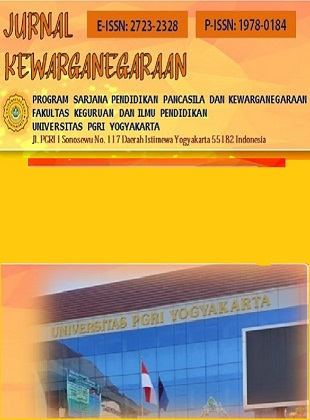Skema Penyelesaian Sengketa Melalui Proses Mediasi Berdasarkan Perma No. 1 Tahun 2016
DOI:
https://doi.org/10.31316/jk.v6i2.3059Abstract
Abstrak
Penelitian yang dilaksanakan mempunyai tujuan guna menjelaskan bagaimana skema lengkap didalam menyelesaikan persengketaan dengan mempergunakan prosedur mediasi. Berdasarkan Perma No.1 Tahun 2016 mengenai Prosedur Mediasi dipengadilan negeri. Dalam Perma No.1 Tahun 2016 mengenai Prosedur Mediasi dipengadilan ialah hasil revisi berdasarkan Perma No.1 Tahun 2008 serta Perma No.2 Tahun 2003, dijelaskan mengenai arti mediasi ialah “langkah menyelesaikan sebuah persengketaan dengan mempergunakan tahapan musyawarah agar mendapatkan kesepakatan seluruh pihak yang mempergunakan bantuan seorang mediator”. Mediator tidak mempunyai sebuah wewenang memutuskan seperti hakim, tapi mempunyai kewenangan agar membuat perdamaian seluruh pihak yang dilibatkan dengan tidak terdapat pihak yang mempunyai perasaan di rugikan berdasarkan kesepakatan yang sudah disepakati. Takdir Rahmadi, mengemukakan bahwasanya seorang tokoh ataupun ahli hukum di Indonesia memberikan pernyataan bahwasanya mediasi ialah sebuah prosedur menyelesaikan sengketa diantara dua ataupun lebih pihak dengan mempergunakan musyawarah ataupun mufakat yang berbantuan pihak yang tidak mempunyai wewenang memutuskan serta bersifat netral. Lembaga pengadilan dipergunakan sebagai sarana guna mewujudkan tujuan peradilan yang pembiayaannya terjangkau, cepat serta sederhana dengan efisien serta efektif, yang diselenggarakan oleh Mahkamah Agung selaku peradilan paling tinggi di Indonesia memulai memberikan gagasan berbagai metode guna mempercepat didalam langkah menyelesaikan sengketa di Pengadilan. Sebuah gagasan yang lumayan progresif diantaranya ialah mengintegrasikan mediasi dipengadilan. Proses mediasi sendiri tersusun dari 3 tahap, yakni tahap pramediasi, tahap proses mediasi serta tahap berakhirnya mediasi. Tahap pramediasi ialah tahap awal yangmana mediatornya membuat susunan beberapa tahapan serta menyiapkannya ketika mediasi belum dilaksanakan. Tahap pelaksanaan mediasi ialah tahap yangmana seluruh pihak yang terlibat sengketa dipertemukan serta bermusyawarah didalam sebuah forum. Serta tahapan akhir yakni implementasi mediasi ialah tahap yangmana seluruh pihak melaksanakan berbagai kesepakatan yang sudah mereka sepakati bersama didalam sebuah perjanjian secara tertulis.
Kata Kunci: Sengketa, Penyelesaian Masalah, Prosedur Mediasi, Mediator Pengadilan
Abstract
The research carried out has the aim of explaining how the complete scheme is in resolving disputes using mediation procedures. Based on Perma No.1 of 2016 concerning Mediation Procedures in district courts. In Perma No.1 of 2016 concerning Mediation Procedures in court, which is the result of a revision based on Perma No. 1 of 2008 and Perma No. 2 of 2003, it is explained about the meaning of mediation as "a step to resolve a dispute by using the stages of deliberation in order to get an agreement from all parties who use it. the help of a mediator". The mediator does not have the authority to decide like a judge, but has the authority to make peace for all parties involved with no party feeling disadvantaged based on the agreed agreement. Takdir Rahmadi, stated that a figure or legal expert in Indonesia stated that mediation is a procedure for resolving disputes between two or more parties by using deliberation or consensus assisted by parties who do not have the authority to decide and are neutral. Court institutions are used as a means to realize the objectives of a judiciary whose financing is affordable, fast and simple, efficiently and effectively, organized by the Supreme Court as the highest judiciary in Indonesia, starting to provide ideas for various methods to speed up the steps to resolve disputes in court. A fairly progressive idea is to integrate mediation in court. The mediation process itself is composed of 3 stages, namely the premediation stage, the mediation process stage and the mediation ending stage. The premediation stage is the initial stage in which the mediator makes arrangements for several stages and prepares them when mediation has not been carried out. The implementation stage of mediation is the stage where all parties involved in the dispute are met and discussed in a forum. And the final stage, namely the implementation of mediation, is the stage where all parties carry out various agreements that they have mutually agreed upon in a written agreement.
Keywords: Dispute, Problem Solving, Mediation Procedure, Court Mediator
References
DAFTAR PUSTAKA
Amarini, Indriati. “Penyelesaian Sengketa Yang Efektif Dan Efisien”. Jurnal Kosmik Hukum. Vol. 16 No. 2 Juni 2016.
Prastowo, Oktafian. “Implementasi Perma No 1 Tahun 2016 Tentang Prosedur Mediasi Di Pengadilan Negeri Surakarta”. Publikasi Ilmiah. Fakultas Hukum Universitas Muhammadiyah Surakarta. 2020.
Puspitasari, Arum Sellya. “Tinjauan Yuridis Perma No. 1 Tahun 2016 Dalam Upaya Meningkatkan Jumlah Penyelesaian Sengketa Secara Damai Di Pengadilan Agama Surakarta”. Publikasi Ilmiah. Fakultas Hukum Universtias Muhammadiyah Surakarta. 2020.
Rahmadi, Takdir. 2017. Mediasi Penyelesaian Sengketa Melalui Pendekatan Mufakat (Edisi Kedua). Depok: Rajawali Pers.
Ratman, Desriza. 2012. Mediasi Non-Litigasi Terhadap Sengkata Medik dengan Konsep WinWin Solition. Jakarta: Elex Media Komputindo.
Stacya Mayang Andani dan Heru Suyanto. “Penyelesaian Sengketa Perdata Melalui Mediasi, Menurut Perma Nomor 1 Tahun 2016 (Studi Kasus Putusan Pengadilan Negeri Jakarta Selatan Nomor 971/Pdt.G/2019)”. Jurnal Ilmu Hukum dan Humaniora. Vol. 8 No. 3 Tahun. 2021.
Downloads
Published
Issue
Section
License
Copyright (c) 2022 Ni Kadek Candra Nanda Devi, Kadek Julia Mahadewi

This work is licensed under a Creative Commons Attribution-ShareAlike 4.0 International License.
Authors who publish with this journal agree to the following terms:
-
The journal allow the authors to hold the copyright without restrictions and allow the authors to retain publishing rights without restrictions.
-
Authors retain copyright and grant the journal right of first publication with the work simultaneously licensed under a Creative Commons Attribution-ShareAlike 4.0 International License that allows others to share the work with an acknowledgement of the work's authorship and initial publication in this journal.
- Authors are able to enter into separate, additional contractual arrangements for the non-exclusive distribution of the journal's published version of the work (e.g., post it to an institutional repository or publish it in a book), with an acknowledgement of its initial publication in this journal.
- Authors are permitted and encouraged to post their work online (e.g., in institutional repositories or on their website) prior to and during the submission process, as it can lead to productive exchanges, as well as earlier and greater citation of published work (See The Effect of Open Access).
This work is licensed under a Lisensi Creative Commons Atribusi-BerbagiSerupa 4.0 Internasional.













